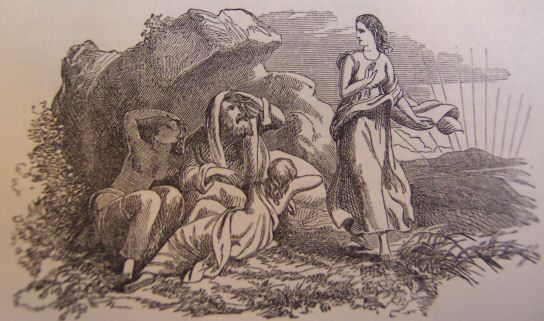Transcribed from a facsimile of the original printing and designof 1863 , email ccx074@coventry.ac.uk
HANDBOOK TO THE SEVERN VALLEY RAILWAY
Illustrative and Descriptive of Places along the Line,
from
WORCESTER TO SHREWSBURY.
BY J. RANDALL, F.G.S.,
author of “severn valley,” etc.
p. 2LEGENDOF THE SEVERN, WYE, AND RHEIDOL.
(See Illustration on the Cover.)
The Welsh are justly proud of their hills and their rivers; theyfrequently personify both, and attribute to them characters correspondingwith their peculiar features. Of the Severn, the Wye, and theRheidol, they have an apologue, intended to convey an idea of theircomparative length, and also of the character of the districts throughwhich they flow. It is called “The Three Sisters,”and in substance is as follows:—In some primitive period of theearth’s history, Father Plinlimmon promised to these nymphs ofthe mountain as much territory as they could compass in a day’sjourney to the sea, by way of dowry upon their alliance with certainmarine deities they should meet there. Sabra, goddess of the Severn,being a prudent, well-conducted maiden, rose with the first streak ofmorning dawn, and, descending the eastern side of the hill, made choiceof the most fertile valleys, whilst as yet her sisters slept. Vaga, goddess of the Wye, rose next, and, making all haste to performher task, took a shorter course, by which means she joined her sisterere she reached the sea. The goddess Rhea, old Plinlimmon’spet, woke not till roused by her father’s chiding; but by boundingdown the side of the mountain, and selecting the shortest course ofall, she managed to reach her destination first. Thus the Cymricproverb, “There is no impossibility to the maiden who hath a fortuneto lose or a husband to win.”
p. 3THESEVERN VALLEY RAILWAY.
The Severn, like other English rivers, may be said to have been thepioneer of railways along its banks: first, in having done much to correctthe inequalities of the surface; secondly, in having indicated the directionin which the traffic flowed; so that early in the history of railwayenterprise eminent engineers, like the late Robert Stephenson, saw thedesirability of following its course, and thus meeting the wants oftowns that had grown into importance upon its banks, wants which theriver itself was unable to supply. In 1846 the route was finallysurveyed by Robert Nicholson, with a view to a through traffic in connectionwith other railways. The scheme met with opposition from advocatesof rival lines. Ultimately, however, the Bill passed the committeesof the two Houses, and the promoters were successful, whilst the expensesof counsel and witnesses were enormous. The original estimatefor the line was £600,000: £110,000 for land, and £490,000for works. £8,500 was down for a girder bridge at Arley,£8,000 for one near Quatford, £9,000 for one above Bridgnorth,and £10,000 for one at Shrewsbury. The two bridges nearBridgnorth and the one near Shrewsbury were abandoned, and a considerablesaving was effected by shortening the line at Hartlebury, by a junction,with the Oxford, Wolverhampton, and Worcester higher up than was originallyintended. The estimated cost of the works, in consequence of thesereductions, and of the determination of the company to make it a singleline, w
